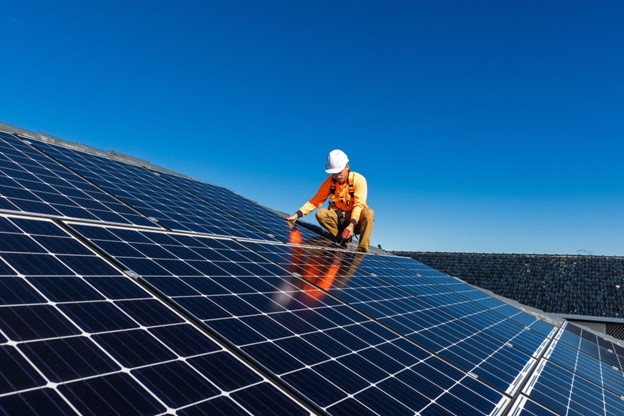Embracing solar energy is an excellent investment in our sustainable future. Not only does it significantly reduce our reliance on fossil fuels, but it also provides economic advantages in the long run.
However, understanding the various cost factors of solar panel installation can be overwhelming. Today, we aim to simplify this process and help you evaluate the investment needed for your solar panel setup.
Understanding Solar Panels
Solar panels are devices that convert the light of the sun into electricity. They’re made of several photovoltaic cells linked together that work to harness the power of the sun.
When sunlight hits these cells, electrons are knocked loose from their atoms, generating an electrical circuit, and voila – we have electricity!
Different Types of Solar Panel Systems
There are usually two types of solar panel systems: Grid-tied and Off-grid.
Grid-Tied Systems are usually connected to your local electric grid. They offer the benefit of net metering, where you can sell back the excess power to the grid, offsetting the installation costs over time.
Off-Grid Systems aren’t connected to an electricity grid and are entirely self-sustaining. They’re often paired with energy storage devices (like batteries) to provide power when the panels aren’t generating electricity (like during night or cloudy weather conditions).
Major Components of Solar Panel Installation Costs
Next, let’s delve into the four significant cost components for installing solar panels.
A. Solar Panels
The cost of the panels themselves usually makes up the bulk of the installation costs. The price will depend based on the type, efficiency, and brand of the panels you choose. Higher efficiency panels generate more electricity per square foot and hence often come with a higher price tag.
B. Inverters
The inverter is a critical device that converts the generated DC (Direct Current) electricity into AC (Alternating Current), which your home appliances can use. The cost of an inverter depends on its type (such as string inverters, microinverters, or power optimizer systems), capacity, and brand.
C. Mounting and Installation Hardware
Hardware and mounting equipment are required to secure the solar panels in place. The type of mounting system can influence costs, with roof-mounted systems usually being cheaper than ground-mounted options.
D. Labor Costs
Finally, labor costs account for a significant portion of your solar panel installation budget. These costs are affected by local rates, the complexity of the installation, and the size of your system. Multiple factors can influence labor costs, such as geographical location, local solar market conditions, and the specific characteristics of your project.
Additional Cost Factors to Consider
When evaluating your solar panel installation costs, other factors could impact the total investment required. This article will explore additional elements you should consider when planning your solar power journey.
A. Size of the System
The size of your solar panel is directly related to the amount of energy you aim to generate. Consequently, the more panels you want to install, the higher the initial investment will be. To calculate the required size, you’ll need to determine your average energy consumption over a set period and the percentage of your consumption you’d like to offset with solar energy.
B. Roof Characteristics
The features of your roof significantly affect the installation costs. For instance, the type of materials used in your roof (asphalt, metal, or slate), its pitch, and age can all influence installation cost and complexity. If your roof needs repair/ replacement it needs, it might make sense to address those issues before proceeding with solar panel installation.
C. Geographic Location
Geographic location plays a vital role in your solar panel installation costs. Some aspects to consider are:
- Solar irradiance levels (the amount of sunlight available in your area)
- Local weather conditions (tendency for heavy snow, ice, or high winds)
- Permitting fees and local regulations
These factors can affect the efficiency and durability of your solar power system, influencing the initial investment and potential energy generation.
D. Solar Incentives and Tax Credits
Various solar incentives and tax credits offered at the federal, state, and local levels can greatly offset your solar panel installation costs. Examples include the Federal Solar Tax Credit (ITC), which reduces the total costs by a significant percentage. Make sure to research and leverage the available incentives in your region to maximize your return on investment.
Cost Comparison: Purchasing Vs. Leasing Solar Panels
When planning your solar panel installation, two main options are available: purchasing and leasing. Each option comes with its advantages and cons, depending on your financial preferences and long-term goals.
Purchasing Solar Panels involves paying the entire upfront cost (or through financing), owning the system, and being responsible for the maintenance. The benefits include:
- Higher long-term savings on energy bills
- Eligibility for tax credits and rebates
- Potential increase in property value
However, some drawbacks include significant initial expenditure and the responsibility for maintenance and repairs.
Leasing Solar Panels is like renting the panels from a solar provider. You pay a monthly fee to use the solar energy they generate while the provider maintains and services the system. Benefits of leasing include:
- Lower upfront costs
- Maintenance and repair handled by the provider
- The ability to produce clean energy without a significant investment
Drawbacks include the potentially higher long-term costs compared to purchasing and ineligibility for tax credits and rebates.
Long-Term Value: Energy Savings and ROI of Solar Panels
When calculating the cost implications of solar panels, it’s vital to consider the long-term benefits and savings that accompany this investment. Although the upfront cost is substantial, the decrease in your energy bills over time results in significant savings. Depending on the size of your system and energy production, you could potentially offset your entire electricity bill.
The Return on Investment (ROI) of the solar panels is found by comparing the upfront and maintenance costs against the money saved from reduced utility bills and revenue from feed-in tariffs or net metering. In many cases, the ROI can be quite attractive, particularly in areas with high electricity prices and sufficient sunlight.
Calculating the Break-Even Point for Your Solar Panel Investment
The break-even point is the time it takes for the energy savings to equal the total cost of your solar panel system, essentially when you start seeing ‘free’ energy. To calculate this point:
- Add up the total cost of your solar setup, including equipment, installation, permits, and potential maintenance.
- Determine your average monthly electricity bill.
- Calculate your estimated monthly energy savings once the solar panel system is operational.
- Finally, divide the total solar panel cost by the monthly energy savings. This gives the number of months it will take to break even on your investment.
This break-even point might occur as early as 6-9 years after installation, depending on your location and system specifications.
Conclusion
The switch to solar energy can seem intimidating initially, primarily due to the substantial upfront costs. However, considering the life-long benefits, environmental impact, and potential savings, solar panel installations are undoubtedly an excellent investment.
It’s important to examine all the elements impacting the costs: the size and type of solar panel system, your roof characteristics, geographic location (like solar maintenance in Houston), available solar incentives, tax credits, and your financing plan.
Remember, going solar isn’t only about immediate returns; it’s also about contributing towards a greener and more sustainable future.
Ultimately, understanding and navigating through these cost considerations will empower you to make the most informed and beneficial decision in your transition to solar energy. And rest assured, the sun won’t be sending you any bills!


